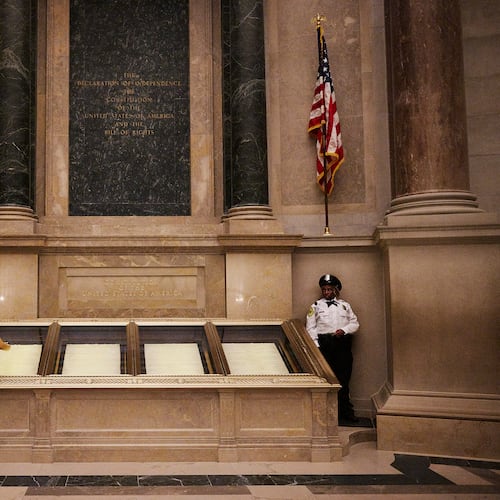Terrica Ganzy
Executive Director of the Southern Center for Human Rights
On Aug. 8, Atlanta Mayor Andre Dickens paid a surprise visit to the City Council’s Public Safety Committee meeting, where the committee planned to discuss a proposed lease of 700 jail beds at the Atlanta City Detention Center to Fulton County.
“We are not in the jailing business,” Mayor Dickens told the committee, before going on to voice his very clear support for expanding Atlanta’s jailing business.
In 2019, then-city councilmember Dickens sponsored legislation that set the course for the closure and repurposing of ACDC. ACDC is a large, imposing building in the heart of downtown Atlanta that is draining millions of dollars from the city’s annual budget, despite sitting mostly empty. On any given day, it holds an average of 30 to 50 people accused of simple traffic or city ordinance violations.
When the Atlanta City Council passed now-Mayor Dickens’ legislation, it was because they knew that ACDC was a waste of city resources, and more importantly, it was not making Atlanta safer. Following a campaign led by Women on the Rise, the Council recognized that ACDC was part of Atlanta’s legacy of criminalizing poverty and homelessness. The city agreed in 2019 to explore recommendations to close and repurpose the jail because of a basic fact: transforming ACDC into a center for supportive services will make Atlanta safer by addressing the root causes of harm.
Despite his 2019 legislation, Mayor Dickens has now changed his tune. Rather than close and repurpose the city jail, the mayor is now championing legislation to lease 700 jail beds at ACDC to Fulton County.
Alongside Fulton County Sheriff Patrick Labat, Mayor Dickens claims that this lease is a “humanitarian” response to overcrowding at the Fulton County Jail. But the issues at the Fulton County Jail are self-made: for decades, the county has refused to follow expert suggestions to alleviate issues of serious overcrowding in its jails — a problem that stems from mismanagement and the overuse of pretrial detention as a response to all community harm.
The mayor and sheriff are not wrong about the crisis in the county’s jails. They are wrong, however, about ACDC as the solution—one that has been proposed, rejected and proposed again every time conditions in Fulton County’s facilities reach a peak crisis.
Framing this lease as a “humanitarian” solution for incarcerated people is a slap in the face to the formerly incarcerated people leading the movement to transform ACDC. Advocates with Women on the Rise, who have themselves spent time on the floors of the Fulton County Jail, have clearly communicated to the mayor that the humanitarian solution is to reduce the jail population—not spread it around the City.
History shows us that this lease is a bad idea. This is not the first time Fulton County has tried to reduce overcrowding by acquiring new jail space. In 2013, the county signed a lease with Union City to move 285 women to the Union City jail to ease overcrowding, in a deal hauntingly similar to the current proposal. Rather than solving the problem, the facility has since faced litigation, as women with severe mental illness languished in solitary confinement for weeks or months on end, decompensating rapidly.
Earlier this year, SCHR, along with the Georgia Advocacy Office, reached a final settlement in Georgia Advocacy Office, et al. v. Labat, et al., a lawsuit filed on behalf of women with severe mental illness incarcerated at what is now the South Fulton Annex (formerly the Union City jail). The judge in the case referred to the jail conditions as “repulsive,” and noted that people familiar with these conditions “really ought to have a hard time sleeping at night.”
New jail space didn’t solve the problem then, and it won’t solve the problem now. In fact, Sheriff Labat himself has made clear that a lease won’t offer a true solution. Speaking to the Fulton County Commission on July 13, 2022, he said “You’re absolutely right, ACDC will not solve the problem. If we got it tomorrow, it would not solve Fulton County’s problem.”
True solutions to resolve the crisis exist: Release the hundreds of people who are only in jail because they are too poor to afford cash bail. Better fund all offices representing people who can’t afford counsel. Hold Fulton prosecutors accountable for over-charging and over-sentencing. Expand pre-arrest diversion services and reverse aggressive police practices. Eliminate the backlog of unindicted cases in the jail. Utilize good time credits to release people serving short sentences.
There is a clear path forward for ACDC, charted many times over. The Reimagining ACDC Task Force, created in 2019, has already done the hard, strategic work of reimagining public safety in Atlanta. Likewise, the city contracted with both the Vera Institute of Justice and Bloomberg Associates for technical assistance on how to quickly and safely close the jail.
Most recently, the Communities over Cages campaign has worked with Councilmembers Keisha Waites, Liliana Bakhtiari and Antonio Lewis to introduce legislation that would achieve this vision by creating the John Lewis Center for Health and Wellness. Erecting the Center would be a practice of true community safety: addressing the root causes of crime and ensuring that Atlantans have the support they need to thrive, instead of trying to arrest our way out of the violence of poverty and homelessness at the taxpayers’ expense.
Ultimately, closing the extra jail is public safety; increasing its capacity to cage people before trial is not. It’s long past time that those in power stick to their promises, listen to the experts and transform ACDC into the John Lewis Center for Health and Wellness.
Terrica Ganzy is the executive director for The Southern Center for Human Rights
Credit: Terrica Ganzy/The Southern Center for Human Rights
Credit: Terrica Ganzy/The Southern Center for Human Rights
About the Author
Keep Reading
The Latest
Featured


